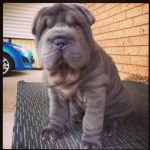STAXAPEI KENNELS
About The Shar Pei
|
The Shar-pei is belived to have decended from, or shared a common origin with the Chow Chow ( because of the blue-black tongue ) - Possibly the Great Pyrenees ( a source of the double dewclaws ) and the Tebetan Mastiff. The first Shar-pei may have appeared as a Mutation. Translated, the name "Shar-pei" becomes "Sandy Dog" Shar - meaning san of a gritty texture. Pei - meaning dog This presents us with a very difinate description of the unique prickly texture and extreme short length of the coat, which resembles a piece of sandpaper, the rare coat was of such importance to the early developers of the breed that it became the instrument through which the Shar-pei was described and named. No other canine possesses this extraordinary type of hair. The correct texture of the coat as described by the Chinese - Should be extremely harsh to touch but at the same time deceive the eye by appearing soft like velour. The coat does have a velvety texture when one strokes the dog from head to tail but if this same coat is stroked against the grain (from tail to head ) it may become abrasive. The desirable trait was sought after and perpetuated by breeders of fighting dogs as this coat discouraged other animals from grasping them with their mouths. Coats do come in two types Horse Coat - Short and Harsh Brush Coat - Longer softer coat about 3/4 inch long Viewed frrom the front. The head of the Shar-pei reminds one of a hippopotamus. The face appears almost flat, with little or no stop from the broad, blunt muzzle. The tounge of the Shar-pei ranges from Lavender to Blueish-Black, a spotted tongue is permissable but a solid Pink tongue is undesirable. The Shar-pei mouth is described as having teeth strong and level, closing in a sissor bite. The canine teeth may be curved, supposedly, this was to cause difficulity in freeing the grip. Small ears and widly set, medium size, almond shaped eyes with a frowning expression complete the picture. Although the small ears are set tightly to the head, they still have a great deal of manouverability and are independent of each other, while listening to different noises, a Shar-pei flicks its ears in and out to the side in much the same way a horse does. The neck is strong and full, set well on the shoulders. The shoulders should be muscular and well laid and sloping. Forelegs should be straight and flexiable ending with feet that are compact and well knuckeled. Hind Quarters are strong and muscular with moderate angulation and well let down hocks. The Body of the Shar-pei should be square, with the chest broad and deep. The Shar-pei `s tail set has three descriptions. First is the tightly curled tail described as a "Coin Tail" . Second is the "Loose Curl" and the Third is the "Arch" This is carried in an arch fashion over the back. The common denominator for all three is that they are carried high, exposing the Anus. The all important forls of the skin on a Shar-pei are just that : All Important. The adult dog should retain wrinkling on the face to present a scowling and dignified countenance. The heavy dewlaps ( folds of the skin around the throat ) provided protection for the throat. The Shoulders and the back in the tail region should retain some wrinkling. Which may extend down the legs. Too little in the way of loose skin offered little protection and to many folds of skin on the body were detrimental as they could be a hinderance to maneuverabilty. So the right amount of wrinlkes was, and still is, imperative in the breeding of Shar-pei. Puppies are more wrinkled than adults and may appear sometimes to be engulfed in a coat many sizes too large for their pudgy frames. Average Size for a Adult is 18- 20 inches at the shoulder and they should weigh between 30 to 40 pounds ( 20 kgs ) Colours range from all shades of Red, Cream, Apricot, Chocolate, Blue Lilac, Isabella . Being sturdy, compact and intelligent, the Shar-pei is perfectly suited to city or country living. They adapt well to hot or cold climates. They are outgoing by nature and are happy indoors or out. They love to ride in cars, and are not barkers ( but will let you know if any body is about ) They are homebodies and rarely stray. Known for their deep loyalty to their family, they are ideal dogs to raise with children. Being both calm and obedient, they do not tend to overreact. The Shar-pei is an enchanting creature, posseessing many qualities shought after in an all-round dog for security as well as companionship. |
